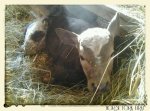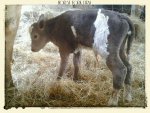(CAUTION- graphic sex talk here. Be warned!)
It's harder to tell on beef cows than dairy cows, for sure! But if she's loosening up around her tailhead, and her vulva is getting soft and swollen, she's getting close. The "cords" (the ligaments and tendons around her tailhead) will get very soft and "fall away" around 12 hours before calving. The "sliming", I assume, is vaginal mucus. That's normal, and in fact, they produce it all through pregnancy. They also will produce copious mucus when they're in heat, but at that time, unless they have an infection, the mucous will be crystal clear and rather thin. "Fetal mucus",OTOH (not an "official" name, but what we've always called it)- what they produce while pregnant- is thicker and stickier, and also just a bit opaque. If you see a THICK (1-2") "string" of rather opaque mucous hanging from her vulva, she has just lost her "mucus plug" that kept the cervix sealed for the last 9 months, and she's in early labor.
Beef cows do a much better job of "hiding" their labor than dairy cows, in our experience. Last week, we had checked over Barbie, a 2 year old Dexter heifer, at 5 pm. She was due the day before, and we knew she was getting close, but after checking her, I didn't think she was calving that night.
TWO HOURS later, I was taking the dogs to the kennel for the night, and shining my flashlight on cow butts, like always. And there Barbie was, in a puddle of amniotic fluid and colostrum, with a tiny black hoof and a navy blue tongue sticking out! I hurried the dogs to the pen, dashed back to the house to get another layer on (it was cold and I thought I was just kenneling the dogs, not spending an hour on a calving!) and fortunately, hubby decided to come out with me. At the time, I thought that I'd seen two feet... but the one leg was back at the shoulder, with the knee wedged under her pelvis.
It took me an eternity to be able to push the calf all the way back in and finally manage to manipulate the leg to get the tiny hoof in position (and I finally had to give her a spinal, as she was pushing so hard) but we saved them both.
That's RARE... but it's something to be watching for. What you MUST see (or feel... and don't hesitate to wash up and reach inside the vaginal tract to make sure the calf is straight) is two feet, "right side up", and a nose lying on top (or slightly to the side) of the legs.
If you have two feet presenting, but they're upside down, you must figure out whether they are front or back feet, and you need to do it before they get far enough out that you can't change things! So, you slide your hand up a leg and feel around until you figure out if it's knees or hocks! If it's knees, the entire calf is upside down, and must be turned. This is a job for a vet or an experienced farmer... I've done it multiple times, but it's WORK. If it's hocks, you've got a breech, and you'll want to pull it as quickly as possible, in order to save it.
But most of the time, everything will be fine, and the first you'll know about it is when you walk out in the morning and find a calf standing next to mama!
If you're able to handle her without being kicked, one "sign" of impending labor and birth is when the teats fill out... they won't get firm or tight in a beef cow, but there will be milk (colostrum) down at their ends. If she's actually dripping colostrum, she's almost certainly in labor (certain high producing dairy cows can break this rule occasionally, but it's rare). Once you see one dripping colostrum, get them into a secure area, and start checking them every half hour or so.
After she calves, offer as much lukewarm water as she wants to drink (old breeders trick... they're "empty" after getting rid of 200# or so of calf and fluid, and letting them drink their fill seems to help them pass the placenta and recover faster), check the calf's navel (if it's broken off right at the belly, you need to make sure there isn't an opening in the belly wall... if there is, it needs a stitch or two. If it's not stitched, either the cow will pull the guts out while she's cleaning the baby off, or they'll start working their way out when it stands. It doesn't usually happen except in a difficult calving with a large calf, but it's something to watch for.
Once you've checked the navel and IF possible, that all four "faucets" work on the cow (DO NOT GET HURT!! If the cow is acting at all aggressive, get out and let nature figure it out!), then just watch on and off over the next 3-4 hours to make sure the calf is up and sucking. If it can't/doesn't get the idea within 6 hours, you'll have to milk the cow and bottle feed the calf, because that colostrum is LIFE. Without it, no matter how much treatment you do, the chances of a calf surviving long is pretty low.
I'm guessing from your description that you may have a calf within a week, if not sooner.
Summerthyme



